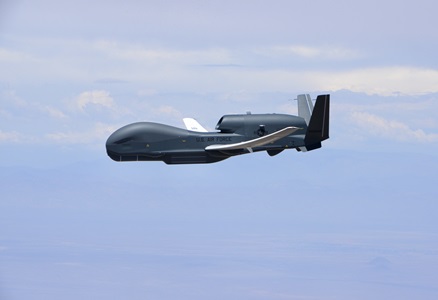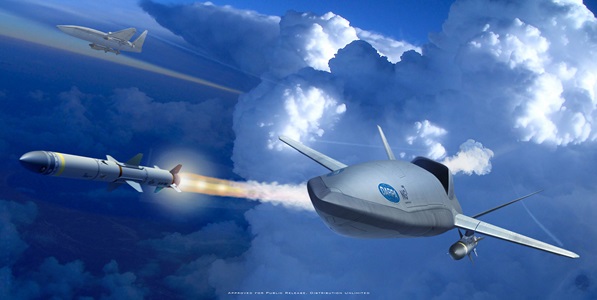MQ-4C Triton Takes Flight with Multi-Intelligence Upgrade

By Brooks McKinney , APR
In late July 2021, Northrop Grumman and the U.S. Naval Air Systems Command (NAVAIR) celebrated a significant milestone in their 13-year partnership developing the MQ-4C Triton maritime surveillance system with the successful first test flight of the newest configuration of the high-altitude, long-endurance autonomous aircraft.
The flight was the latest step in a development process designed to help Triton achieve initial operational capability (IOC) status in 2023. Two Triton aircraft configured with "early operational capability" hardware and software have been operating in the Pacific since early 2020.
Adding Intelligence Capabilities
According to Rob Zmarzlak, chief engineer for Northrop Grumman's Autonomous ISR and Targeting Programs, the newest configuration — known as Integrated Functional Capability (IFC)-4 or MQ-4C Triton Multi-INT — dramatically improves the system's signals intelligence (SIGINT) capabilities.
"Triton Multi-INT gets its name from the addition of two new SIGINT sensors: one that gathers electronic intelligence and one that gathers communications intelligence," he said. "We've also removed an older electronic support measures sensor and installed a new, more capable version of the electro-optical infrared sensor flying on Triton today."

Reconfiguring Reality with Stringent Security Requirements
The new sensors on Triton Multi-INT and their higher data security requirements have dictated significant hardware and software changes throughout the aircraft and its ground segment.
"We now have a radar actively transmitting radio frequency energy and sensors listening for quiet electronic signatures on the same platform," Zmarzlak explained. "We had to do a lot of electromagnetic interference and shielding work to prevent energy from the radar from interfering with the receivers of the SIGINT sensors."
Nimish Kurani, a Northrop Grumman systems engineer, noted that the new sensors also came with challenging software requirements.
"We had to write new software both to manage the operation of the sensors and to route their data properly from the air vehicle to the ground," he said. "Each sensor has its own security requirements, so we have to keep each data stream separate as it flows over the network."
Kurani added that, as part of Triton Multi-INT, Northrop Grumman also upgraded the voice system that allows Triton operators at the forward operating base and the main operating base (MOB) to communicate with each other and air traffic controllers through the aircraft.
Simulated Testing for the Mission
According to Kurani, Northrop Grumman conducted much of the initial Triton Multi-INT integration and testing work at its Triton Systems Center (TSC) in San Diego. The TSC includes a simulated ground segment, a "hot bench" containing hardware for two simulated Triton autonomous aircraft and simulated (hardwired) wideband SATCOM links that connect the ground segment to the "aircraft."
"Our goal is always to 'test like we fly,'" said Kurani. "It's important to experience and resolve every test anomaly in the lab exactly as if we were flying a real Triton mission. Otherwise, we'll never know if we're prepared to respond properly to mission contingencies."
Integrating with Care
For Luis Guerrero, a Northrop Grumman systems integration specialist, Triton Multi-INT integration was both challenging and rewarding.
"During systems integration, we verified that all of our systems are communicating properly and that we didn't have any invalid data going through the system," he explained. "I always operate the system from the mindset of a UAV pilot or payload operator. If I see something that doesn't look right, I immediately dig deeper and investigate what's going on."
Guerrero noted that after everything checked out in the lab, Triton Multi-INT still had to pass its acceptance test procedure (ATP) at Patuxent River Naval Air Station.
"ATP verifies that Triton Multi-INT has been installed and integrated properly in the Triton aircraft and ground segment," he said. "We conducted ATP between January and June 2021 in collaboration with our production team at Pax River."

Testing Triton before Takeoff
According to Kurani, Northrop Grumman and the Navy's VX-20 Test Squadron established their first connection between the newly configured Triton Multi-INT air vehicle and ground segment in early 2021. In the weeks leading up to first flight, the integrated test team conducted a series of ground-based test events to verify that the air and ground systems were functioning properly and would pose no risk to the aircraft launch, control and recovery processes.
"After completing ATP and static ground testing, we built up to dynamic test events, including low-speed and high-speed taxis, taxi-abort and, ultimately, takeoff and first flight," said Kurani.
The flight took place in the airspace near Paxtuxent River, MD and lasted about four and a half hours. It proved that the MQ-4C Triton Multi-INT aircraft flies properly, that its new voice communications system works well and that the team can monitor the health and status of its sensors.
In the coming months, Northrop Grumman and NAVAIR will conduct additional Triton Multi-INT test flights, including more comprehensive testing of its sensors.
Delivering Broad Area Maritime Surveillance Across Seas
As Triton Multi-INT moves closer to IOC, the Northrop Grumman/NAVAIR team has much to look forward to.
"The development and deployment of this autonomous aircraft system by the Navy marks a significant change in its ability to conduct maritime surveillance," Zmarzlak said. "The team's commitment to excellence will bring a persistent, unblinking view of the most strategic parts of the world’s oceans and, with it, the ability to respond quickly and diplomatically to urgent international situations."
More innovation stories
Read all stories about advanced technology and innovation >>


